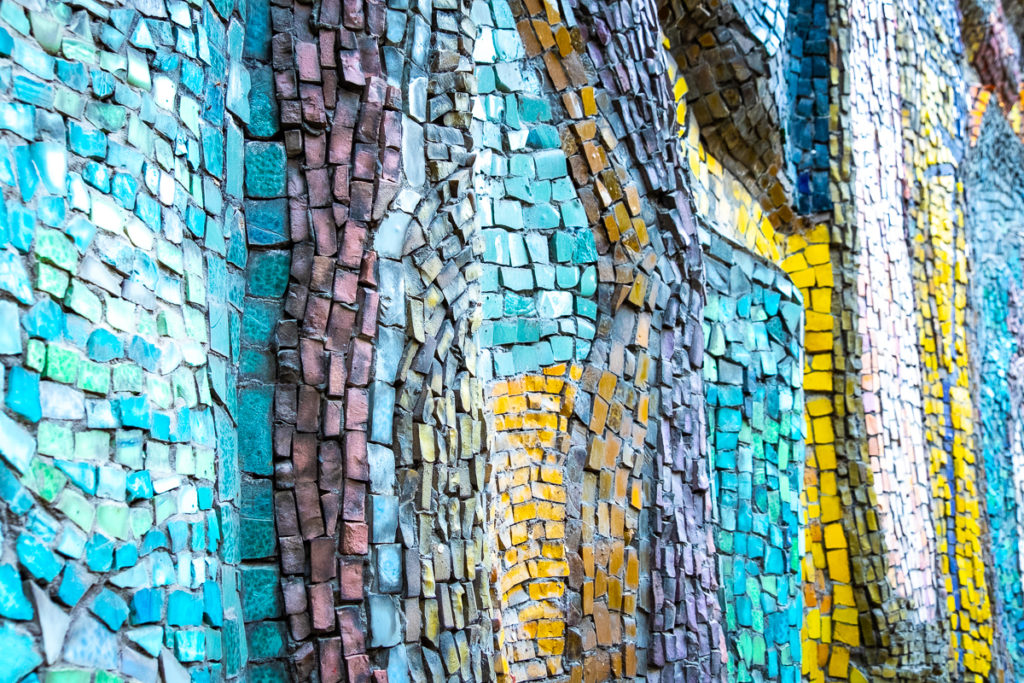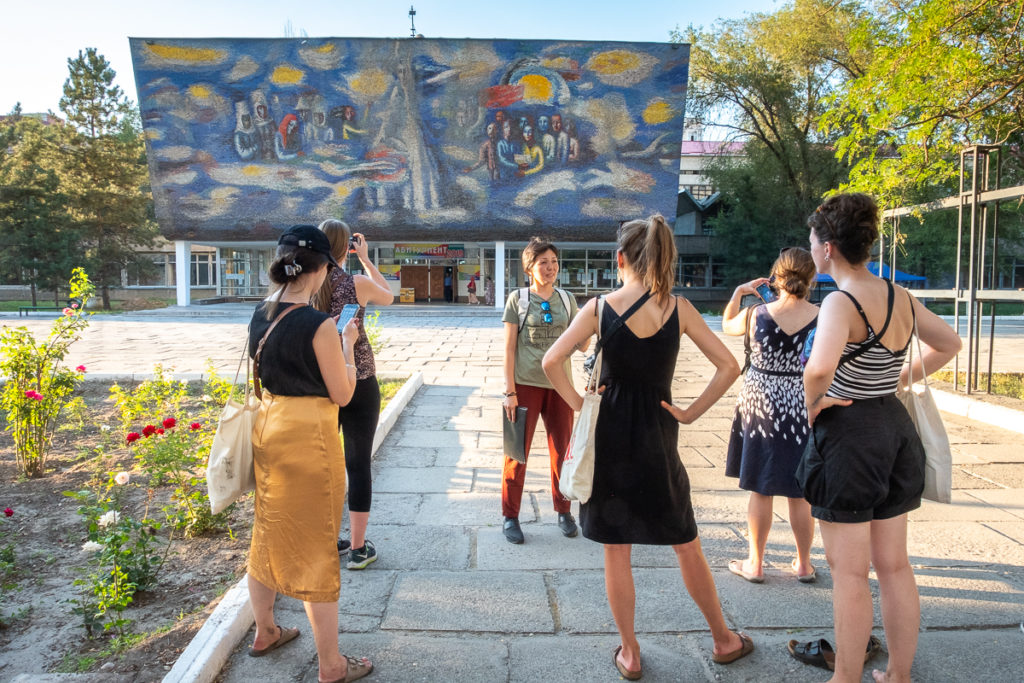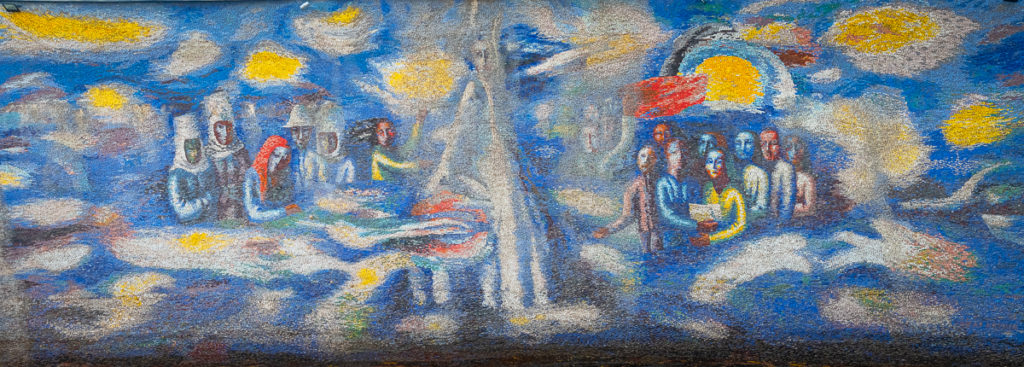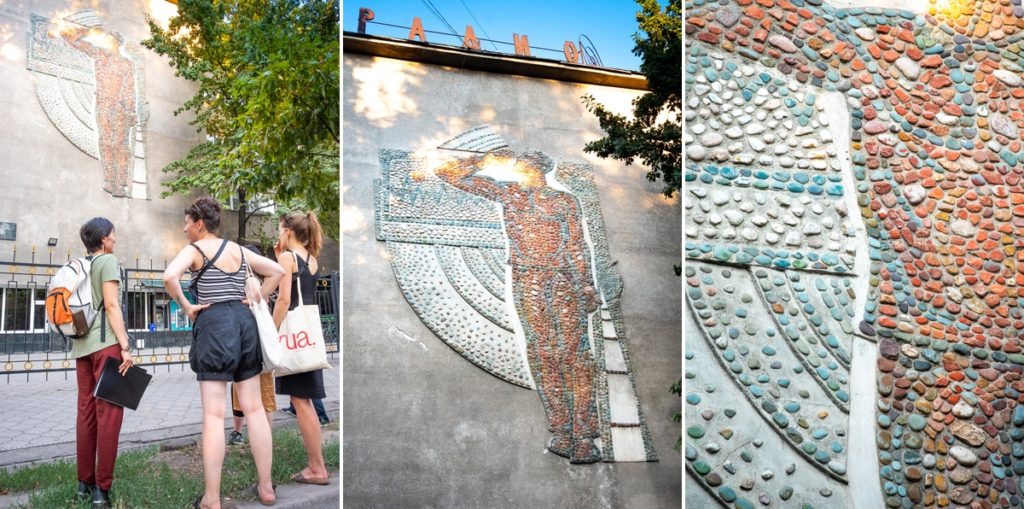Having explored an obscure but interesting part of the history of Kyrgyzstan’s capital on the Interhelpo: The making of industrial Bishkek walking tour with Bishkek Walks, I immediately signed up for Rahat’s Mosaics of Bishkek: Soviet Street Art exploration. I have a particular fascination for street art wherever I go so was very keen to see what Bishkek had to offer.

An added interest for this particular tour was that all of these artworks were created between the 1960s and 1980s to highlight the positive elements of the Soviet system and “inspire citizens with beautiful everyday surroundings”. I was curious to see what this looked like.
Sunny Fish Fountain
We met less than 100m from where I’m staying in central Bishkek (literally around the nearest corner) at a large fountain that I must have walked past at least 10 times but never noticed! 😳

The Sunny Fish Fountain was built in 1982 by Russian designer Vladimir Krugman as Soviet limitations on artistic freedom were relaxing. It is pretty easy to see how it got its name 🙂

The tiles are made from melted glass stained with different compounds, some of which had to be transported all the way from Belarus. The artists involved in the project had to travel, create each tile, transport it back to Bishkek and erect the statue themselves – quite an undertaking for a fountain as large as this!

Ala-Too Movie Theatre
Our next stop was a few blocks away at the avant-garde Ala-Too movie theatre. This is the oldest cinema in Bishkek and is recognised as a cultural monument of the Kyrgyz people. Rahat explained a little about the history of social change in Kyrgyzstan during the life of the theatre, before focusing in on the artwork that decorates the upper part of the building.

It turns out, this is not the original decoration! In 1963, to mark the 100th anniversary of Kyrgyzstan joining Russia, the original horses were replaced by panels showing the achievements of the Soviet Union, including a man with a dove to symbolise peace, a cosmonaut to represent scientific achievements, and people reading books to symbolise education.

Labor mosaic
After a stop at the Monument of Friendship (another creation to mark 100 years of Kyrgyzstan joining Russia) and a discussion of the Women mosaic and others that visitors are now not able to see because they are located in a privately owned buildings, we walked about 1km west to find our next artwork.
The Labor mosaic by Mihail Bochkarev and Altymysh Usubaliev was created in 1964 and was one of the first mosaics in Krygyzstan. The panel depicts some of the working class of the Soviet Union (farmers and factory workers) and also some of the more intellectual achievements (scientists sending rockets to outer space).

They used river pebbles as a cheap and convenient material to create the artwork, and it is an example of how artists attempted to beautify empty space on the walls of otherwise boring Soviet buildings.
An unusual thing about this mosaic is that it includes a panel with the names of the artists. Since artwork was supposed to be created for the enjoyment of all people, the artists themselves were generally not deemed important and very few include this acknowledgement.
The Path to Enlightenment mosaic
Another kilometre further west (yes, there is a fair bit of walking in this tour), we arrived at one of the campuses of the Kyrgyz National University whose back entrance sports an amazing mosaic called The Path to Enlightenment.

Created in 1974 by Satar Aitiev, it remains a mystery how this particular mosaic was even allowed! During this period, the Kyrgyz Union of Artists dictated that all artwork had to be accessible and easily understandable to the common person without explanation or interpretation. They had a lot of control over what an artist could create and would intervene in the design of artworks if they did not adhere to their guidelines

Its modernist, painting-like feel was completely at odds with anything that had ever been done in before Kyrgyzstan and definitely requires some interpretation! The passive figures are in stark contrast to the strong and active figures typical of Soviet style art, and although religion was not part of the Soviet era in Kyrgyzstan, the central figure is almost spiritual in nature.
Radio and Nowadays mosaic
Our next stop was Bishkek’s telecommunications office and its very relevant mural of a giant sending out radio waves. Science was a favourite topic for artists during the Soviet time (we’ve already seen scientists depicted in the murals above), and this science-related mosaic was again made from cheap, local pebbles.

The Lenin is with us mosaic
The final artwork we visited on the tour, Lenin is with us, turned out to be another vast mural canvas. Created in 1978 by Lidia Ilyina (a rare female artist), it depicts the whole of Soviet society, including soldiers of the Red Army, female and male working class citizens, students, pioneers and, of course, Lenin.

Interestingly, all of the men are depicted with some kind of profession while the women play a support role. As a female artist, whether this was her artistic impression of the realities of society at the time and she wanted to send a message within the constraints of the Artist’s Union guidelines, or whether it was simply an order from the state – nobody knows.

We also don’t know whether the fact that Lenin (depicted in his classic posture showing the way to communism) occupies a significant portion of the mural perhaps indicates the artist felt that Lenin was being forgotten. Unfortunately, records were not kept about any of the artworks created at the time and so many remain open to historical interpretation.

Recommendation
If you are interested in the history of a location told through artwork, the Bishkek Mosaics Walking Tour is fantastic.
Rahat had a lot of information about each of the mosaics and wove them together with the story of the Kyrgyzstan’s Soviet era history in a really amazing tour. She covered a lot more than what I’ve summarised above so definitely do the tour to learn more!
Time: 2hrs. Note: it is about 4km of walking and you end in a different place from where you start. Rahat can offer advice on how to get back to where you need to go.
Cost: About USD$10 – $22 depending on number of people.
